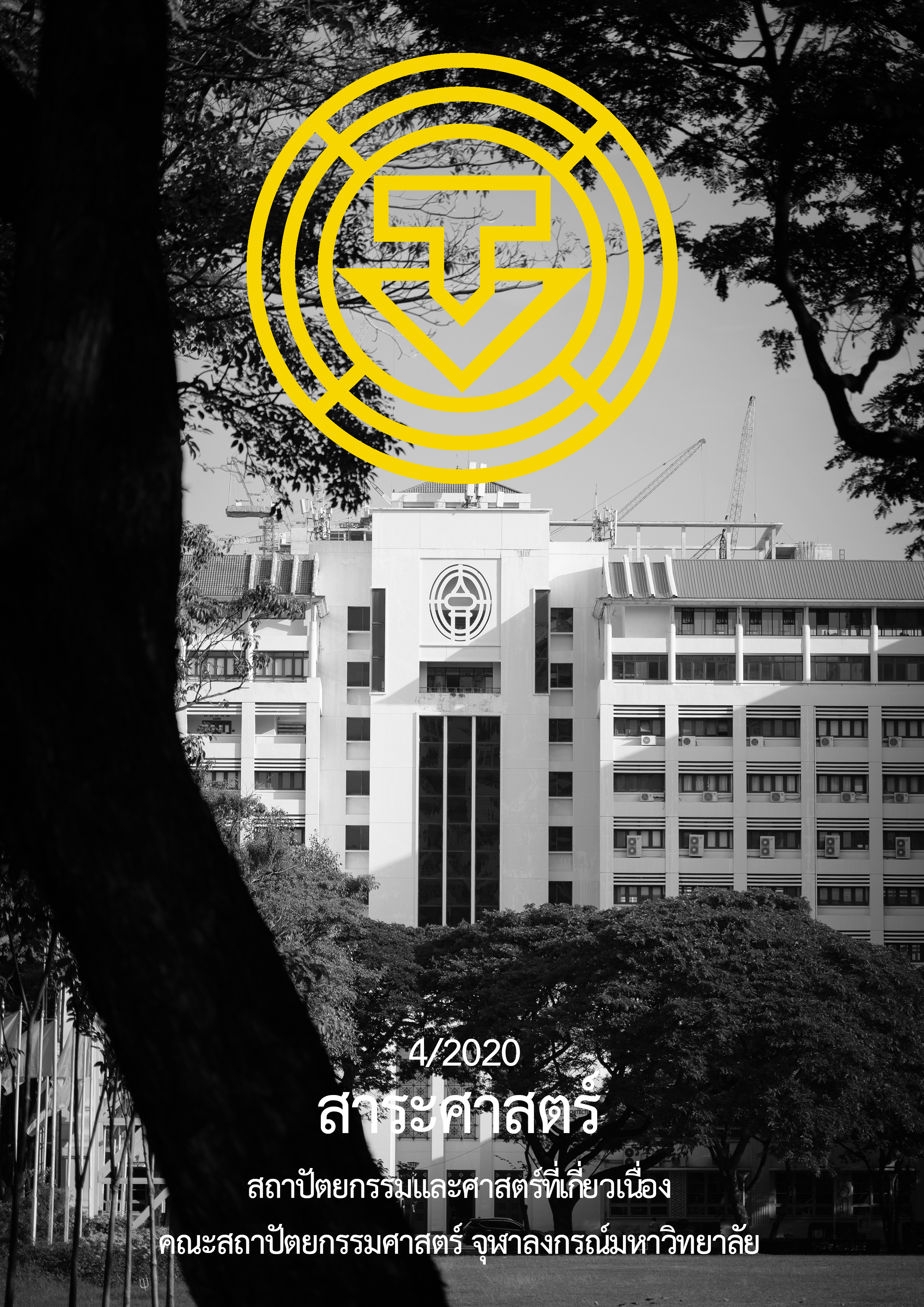Development of Building Information Modeling (BIM) Tools to Calculate The Stormwater Runoff in Preliminary Design Stage
Main Article Content
Abstract
Currently, flooding is a problem that occurs frequently. Which mostly occurs in developed areas such as Bangkok. Which makes various design criteria, such as LEED, TREES and EIA, with the concept of design criteria to delay water within the project area so water outside the project area could be discharged to the public system in time. It is necessary to calculate the amount of stormwater runoff volume and discharge rate. The stormwater runoff volume calculation tools nowadays, such as manual calculations, Microsoft Excel worksheets or using the stormwater management programs, are complex and complicated for designers. It also requires knowledge of stormwater management to use these tools. Currently, the Building Information Model (BIM) is being used in the design of various projects. The most popular program in Thailand is Revit, which has an add-on program called Dynamo that can retrieve data from Revit to calculate complex mathematical data. Therefore, in this research, have used Revit and Dynamo to develop the stormwater runoff calculation tool that can automatically calculate the stormwater runoff volume and discharge rate. The process to develop the tools is literature reviewing, target survey and tools developing. Furthermore, comparing the calculation results to check the accuracy of the developed tools. By comparing the result from the developed tools with the result from the calculation in Microsoft Excel. It appears that the developed tool has the maximum error of ± 2.52% which occurs from using the Dynamo script in Dynamo 2.3 which has the limitation of tools.
Article Details
References
เดชา บุญค้ำ. (2557). การวางผังบริเวณและงานบริเวณ. กรุงเทพฯ: สำนักพิมพ์แห่งจุฬาลงกรณ์มหาวิทยาลัย.
กรมควบคุมมลพิษ. (2558). พระราชบัญญัติส่งเสริมและรักษาคุณภาพสิ่งแวดล้อมแห่งชาติ พ.ศ.2535 กฎ ประกาศ และระเบียบที่เกี่ยวข้องด้านการควบคุมมลพิษ. กรุงเทพฯ: โรงพิมพ์องค์การสงเคราะห์ทหารผ่านศึก.
กรมอุตุนิยมวิทยา. (2561). ปริมาณน้ำฝน. สืบค้นเมื่อ 18 พฤศจิกายน 2562, จาก https://tmd.go.th/info/info.php?FileID=55
ชวนนท์ โฆษกิจจาเลิศ. (2556). การตรวจสอบแนวทางการประยุกต์ใช้วิธีการจัดระดับชั้นความละเอียดของข้อมูลสำหรับแบบจำลองสารสนเทศอาคารของสถาบันอเมริกัน กับวิธีการหาปริมาณงานสถาปัตยกรรมในอุตสาหกรรมการก่อสร้างของไทย. (วิทยานิพนธ์ปริญญามหาบัณฑิต, จุฬาลงกรณ์มหาวิทยาลัย).
ณัชชา เอกร่าเริงแสน. (2559). การพัฒนาโปรแกรมเสริมในแบบจำลองข้อมูลสารสนเทศอาคารเพื่อช่วยวิเคราะห์เส้นทางหนีไฟในอาคาร. (วิทยานิพนธ์ปริญญามหาบัณฑิต, มหาวิทยาลัยธรรมศาสตร์).
ณัฐรดา บุญถัด (2560). การคำนวณค่าสัมประสิทธิ์การบังแดดของอุปกรณ์บังแดด (SC) ด้วยโปรแกรม Revit & Dynamo ตามหลักเกณฑ์การคำนวณของกฎหมายพลังงาน (BEC). (วิทยานิพนธ์ปริญญามหาบัณฑิต, มหาวิทยาลัยเกษตรศาสตร์).
ดำรงศักดิ์ ริมชุมภู. (2560). การกำหนดค่าการซึมน้ำฝนไหลนองบนสวนซับน้ำฝนสำหรับงานภูมิสถาปัตยกรรม. (วิทยานิพนธ์ปริญญามหาบัณฑิต, มหาวิทยาลัยศิลปากร).
ThaiBIMpro. (2015). การเขียนโปรแกรมด้วยการวาดโปรแกรม Dynamo. สืบค้นเมื่อ 18 พฤศจิกายน 2562, จาก http://thaibimpro.blogspot.com/2015/12/dynamo.html
ธัญธร ค้ำไพโรจน์. (2560). เครื่องมือเสริมบนแบบจำลองสารสนเทศที่ช่วยในการประเมินการปล่อยก๊าซเรือนกระจกตลอดวัฏจักรชีวิตของอาคาร ตั้งแต่ขั้นตอนการออกแบบขั้นต้น กรณีศึกษา อาคารพักอาศัย. (วิทยานิพนธ์ปริญญามหาบัณฑิต, จุฬาลงกรณ์มหาวิทยาลัย).
วรพงศ์ โรจน์อนุสรณ์. (2559). การพัฒนาโปรแกรมเสริมเพื่อการตรวจสอบกฎหมายอาคารด้วยแบบจำลองสารสนเทศอาคาร กรณีศึกษา: อาคารที่อยู่อาศัยขนาดใหญ่ในเขตกรุงเทพมหานคร. (วิทยานิพนธ์ปริญญามหาบัณฑิต, มหาวิทยาลัยธรรมศาสตร์).
สถาบันอาคารเขียวไทย. (2557). เกณฑ์การประเมินความยั่งยืนทางพลังงานและสิ่งแวดล้อมสำหรับการเตรียมความพร้อมการก่อสร้างและอาคารปรับปรุงใหม่. สืบค้นจาก www.tgbi.or.th>trees
สมาคมสถาปนิกสยามฯ. (2558). คู่มือปฏิบัติวิชาชีพ แนวทางการใช้งานแบบจำลองสารสนเทศอาคาร สำหรับประเทศไทย (Thailand BIM Guideline). กรุงเทพฯ: สมาคมสถาปนิกสยามในพระบรมราชูปถัมภ์.
อภิเกียรติ เจริญสุทธิโยธิน. (2560). แนวทางการพัฒนาแบบจำลองสารสนเทศอาคาร (BIM) เพื่อการคำนวณค่าการถ่ายเทความร้อนรวมของผนังด้านนอกของอาคาร (OTTV) ในขั้นตอนการออกแบบเบื้องต้น. (วิทยานิพนธ์ปริญญามหาบัณฑิต, จุฬาลงกรณ์มหาวิทยาลัย).
Autodesk.(2019).What Is Autodesk storm and sanitary analysis? Retrieved 2019, November 19, from https://knowledge.autodesk.com/support/civil-3d/troubleshooting/caas/CloudHelp/cloudhelp/2019/ENU/Installation-Civil3D/files/GUID-A4080DA5-3C5C-47E3-9396-F42FD24DBF2C-htm.html
Eastman, Chuck, Teicholz, Paul, Sacks, Rafael & Liston, Kathleen. (2011). BIM handbook: A guide to building information modeling for owners, managers, designers, engineers, and contractors. Toronto: John Wiley & Sons, Inc.
Ferguson, B. L. (1998). Introduction to stormwater. Toronto: John Wiley & Sons, Inc.
Krygiel, E. (2008). Green BIM: Successful sustainable design with building information modeling. Toronto: John Wiley & Sons, Inc.
Thai Green Building Institute. (2017). Thai’s rating of energy and environmental sustainability for new construction and major renovation and core and shell building. Retrieved from www.Tgbi.or.th>tag>show
The Dynamo Primer. (2019). What is visual programming? Retrieved 2019, November 19, from https://primer.dynamobim.org/01_Introduction/1-1_what_is_visual_programming.html
U.S. Green Building Council. (2014). LEED reference guide for neighborhood development. Washington, DC: U.S. Green Building Council.
Water Environment Federation American Society of Civil Engineers. (1992). Design and construction of urban stormwater management systems. New York: American Society of Civil Engineers.


